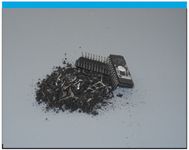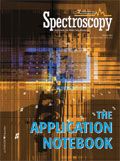Sample Preparation of Electrical and Electronic Scrap
Retsch, Inc.
The widespread proliferation of "electrotechnical" products has drawn increased attention to their impact on the environment. Many parts of the world, including the European Community, China, and California have current or proposed regulations regarding the use of certain substances such as lead, mercury, cadmium, hexavalent chromium, and some types of brominated flame retardants. For example, the European RoHS directive prohibits these materials from being used in electronic and electrical equipment after 1 July 2006.

Therefore, the industries involved are looking for testing protocols for these regulated substances and while there are in most cases-approved analytical methods available, one major issue concerns that of sample preparation. These electrotechnical products come in many forms from relatively simple devices such as toys and fitness equipment all the way through to complex instruments and computers each of which contains many different sub assemblies falling under this same category. The challenge is then producing a representative neutral-to-analysis sample from a heterogeneous mixture of plastic, metal, ceramics, and composites.
In order for the required analyses to be performed, the materials need to be reduced in size to 200 microns or less for analysis. Even after initial size reduction using cutters and similar devices, it is necessary to go through a two stage size-reduction process in order to reach this required size. Following the recommendations of a recent draft document from IEC, the materials should be initially processed in a Cutting Mill, such as a Retsch SM 2000 with 1 and 4 mm sieves. This mill is particularly suitable since it can handle hard and ductile as well as soft and elastic materials. Up to 5 L of material can be processed to a fineness of less than 6 mm. With the help of a sample divider (Retsch PT 100 or equivalent), a representative subsample is obtained for further size reduction to analytical fineness.

Figure 1. From power cord to analytical sample.
The IEC document recommends that fine grinding be carried out in a Centrifugal Mill (Retsch ZM 200 or similar) equipped with tungsten reinforced grinding tools to help minimize wear and avoid the risks of introducing impurities during milling. This very efficient mill is characterized by very short grinding times and also by its ability to handle material that has been prechilled with liquid nitrogen or dry ice. This not only improves the breaking properties of the material but avoids frictional heat and ensures that volatile fractions are not adversely affected.
In the USA, there is some debate amongst the standards community as to whether or not compliance should be based on the homogenous approach which is one that looks only at the individual components and materials that are used within a finished product, or the whole product approach which requires the final product to be tested in its entirety.

Figure 2. Preliminary size reduction of Eproms (with Cutting Mill SM 2000).
In both approaches, sample preparation is a critical since without a good representative sample, there can never be a precise and meaningful analysis result. Meanwhile as of 1 July 2006, any electrical or electronic product exported to the European community must show that the whole device complies with these regulations.
U. S. manufacturers are starting to realize the importance of these regulations and are looking to equip themselves in order to be in compliance. Some companies are already prepared for this and others rely on the expertise and testing facilities offered by the environmental laboratories such as Environmental Monitoring and Technologies (EMT, Morton Grove, Illinois). In this well equipped facility, laboratory manager Vince Donndelinger uses both the Retsch SM 2000 and ZM 100 mills to process various electronic devices including cell phones. Marketing manager Kris Erikson comments that the presence of the Retsch equipment has allowed them to stay fully abreast and in fact ahead of the current regulations, and they see an increasing demand for their services in the future as the regulations take effect.

Figure 3. Retsch Cutting Mill SM 2000 a primary grinder and Ultra Centrifugal Mill ZM 200 for the fine grinding stage.
As EMT have found, having these two Retsch mills makes it relatively easy to be in compliance with the existing and future regulations which are expected to become more stringent as the world realizes the importance of not continuing to dump toxic materials into the environment.
Retsch, Inc.
74 Walker Lane, Newtown, PA 18940
Tel. (866) 473-8724

Thermo Fisher Scientists Highlight the Latest Advances in Process Monitoring with Raman Spectroscopy
April 1st 2025In this exclusive Spectroscopy interview, John Richmond and Tom Dearing of Thermo Fisher Scientific discuss the company’s Raman technology and the latest trends for process monitoring across various applications.
A Seamless Trace Elemental Analysis Prescription for Quality Pharmaceuticals
March 31st 2025Quality assurance and quality control (QA/QC) are essential in pharmaceutical manufacturing to ensure compliance with standards like United States Pharmacopoeia <232> and ICH Q3D, as well as FDA regulations. Reliable and user-friendly testing solutions help QA/QC labs deliver precise trace elemental analyses while meeting throughput demands and data security requirements.